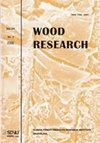落叶松原木风干过程中振动的演化与分布
IF 1
4区 农林科学
Q3 MATERIALS SCIENCE, PAPER & WOOD
引用次数: 0
摘要
本文分析了落叶松(Larix principles rupprechtii Mayr)1m长、初始含水率为66%的原木在空气干燥过程中抖动的长度、宽度和位置。研究了落叶松原木干燥过程中振动的发展规律和分布特征,从微观结构和生长缺陷两个方面分析了振动的产生和发展规律。利用分体式应力测试条,分析了干缩变形沿径向的变化及其结对干缩变形的影响。在细胞水平上,观察了心材和边材的细胞壁收缩行为以及节的微观结构。结果表明,离心率与振动分布之间存在显著关系;IIa区域最容易发生干抖。抖动的演变与干燥速率密切相关。在高速干燥阶段(MC≥40%),几乎不会发生抖动;在减速干燥阶段(40%≥MC≥20%),抖动的数量、长度和宽度迅速增加。在低速干燥阶段(20%≥MC),抖动面积趋于稳定甚至下降。干摇的主要原因是切向和径向细胞壁、早期和晚期木材、心材和边材之间的干缩差异,以及干燥过程中的含水量梯度。本文章由计算机程序翻译,如有差异,请以英文原文为准。
EVOLUTION AND DISTRIBUTION OF SHAKES IN LARCH LOGS DURING AIR DRYING
This paper analyzed the length, width, and location of shakes in the air-drying process of larch log (Larix principis-rupprechtii Mayr) 1 m long and 66% initial moisture content. The development law and distribution characteristics of shakes during log drying of larch were studied and shake generation and development law were analyzed from two aspects of microstructure and growth defects. The variation of dry shrinkage deformation along the radial direction and knot influence on it was analyzed using the split-shaped stress test strips. At the cellular level, the cell wall shrinkage behavior of heartwood and sapwood and the microstructure of knots were observed. The results showed a significant relationship between eccentricity and shake distribution; the IIa region is the most prone to dry shake. The evolution of shakes is closely related to the drying rate. In the high-speed drying stage (MC ≥ 40%), shakes almost do not occur; in the decelerating drying stage (40% ≥ MC ≥ 20%), the amount, length, and width of shakes increase rapidly. In the low-speed drying stage (20% ≥MC), the area of shakes tends to stabilize or even decline. The main reasons for dry shaking are the dry shrinkage difference between tangential and radial cell walls, early and late wood, heartwood and sapwood, and moisture content gradient during the drying process.
求助全文
通过发布文献求助,成功后即可免费获取论文全文。
去求助
来源期刊

Wood Research
工程技术-材料科学:纸与木材
CiteScore
2.40
自引率
15.40%
发文量
81
审稿时长
5.4 months
期刊介绍:
Wood Research publishes original papers aimed at recent advances in all branches of wood science (biology, chemistry, wood physics and mechanics, mechanical and chemical processing etc.). Submission of the manuscript implies that it has not been published before and it is not under consideration for publication elsewhere.
 求助内容:
求助内容: 应助结果提醒方式:
应助结果提醒方式:


